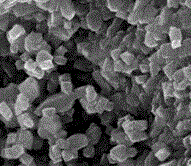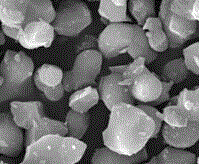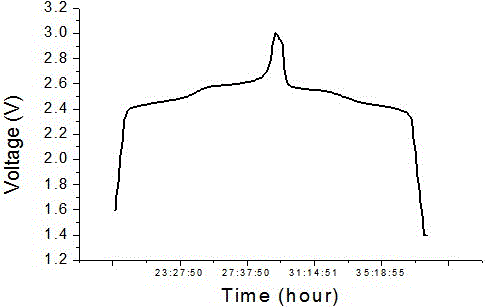Making method of lithium ion battery
The technology of a lithium-ion battery and a manufacturing method is applied in the field of lithium-ion battery manufacturing, which can solve problems such as battery short circuit, achieve the effects of increasing electrical conductivity, low manufacturing cost, and suppressing the Jahn-Teller effect
- Summary
- Abstract
- Description
- Claims
- Application Information
AI Technical Summary
Problems solved by technology
Method used
Image
Examples
Embodiment 1
[0020] Prepare the positive electrode material. Weigh a certain amount of raw materials such as lithium nitrate, aluminum nitrate, manganese dioxide, and lithium fluoride according to the molar ratio of Li:Al:Mn:F of 1:0.03:1.95:0.05, put the above raw materials into a ball mill tank, and put them into Agate grinding balls, adding ethanol additives, ball milling for 4 hours to obtain a mixed slurry, which was transferred into a sagger, put into a resistance wire horizontal tube furnace, and heated at 5°C min -1 The heating rate was heated to 750 °C, kept for 10 hours, then cooled to room temperature with the furnace, and crushed to obtain Li 1.05 Al 0.03 mn 1.95 o 3.95 f 0.05 Cathode material;
[0021] Preparation of negative electrode materials. Lithium carbonate and nano-titanium dioxide were selected as raw materials, and the raw materials were weighed according to the Li:Ti molar ratio of 4:5. Put the above raw materials into a ball mill jar, add 20% sucrose of the ...
Embodiment 2
[0026] Prepare the positive electrode material. Weigh a certain amount of lithium carbonate, aluminum nitrate, manganese dioxide, lithium fluoride and other raw materials according to the molar ratio of Li:Al:Mn:F of 1:0.03:1.95:0.05, put the above raw materials into a ball mill jar, and put them into agate Grinding balls, adding ethanol additives, and ball milling for 4 hours to obtain a mixed slurry, which was transferred into a sagger, put into a resistance wire horizontal tube furnace, and heated at 10°C min -1 The heating rate is heated to 750 °C, kept for 12 hours, then cooled to room temperature with the furnace, and crushed to obtain Li 1.05 Al 0.03 mn 1.95 o 3.95 f 0.05 Cathode material;
[0027] Preparation of negative electrode materials. Lithium carbonate and nano-titanium dioxide were selected as raw materials, and the raw materials were weighed according to the Li:Ti molar ratio of 4:5. Put the above raw materials into a ball mill jar, add 30% sucrose of t...
Embodiment 3
[0032] Prepare the positive electrode material. Weigh a certain amount of raw materials such as lithium carbonate, aluminum nitrate, manganese acetate, and lithium fluoride according to the molar ratio of Li:Al:Mn:F of 1:0.03:1.95:0.05, put the above raw materials into a ball mill jar, and put them into agate for grinding balls, added ethanol additives, and ball milled for 3 hours to obtain a mixed slurry, which was transferred into a sagger, put into a resistance wire horizontal tube furnace, and heated at 10°C min -1 The heating rate is heated to 700 °C, kept for 8 hours, then cooled to room temperature with the furnace, and crushed to obtain Li 1.05 Al 0.03 mn 1.95 o 3.95 f 0.05 Cathode material;
[0033] Preparation of negative electrode materials. Lithium carbonate and nano-titanium dioxide were selected as raw materials, and the raw materials were weighed according to the Li:Ti molar ratio of 4:5. Put the above raw materials into a ball mill jar, add sucrose with ...
PUM
 Login to View More
Login to View More Abstract
Description
Claims
Application Information
 Login to View More
Login to View More - Generate Ideas
- Intellectual Property
- Life Sciences
- Materials
- Tech Scout
- Unparalleled Data Quality
- Higher Quality Content
- 60% Fewer Hallucinations
Browse by: Latest US Patents, China's latest patents, Technical Efficacy Thesaurus, Application Domain, Technology Topic, Popular Technical Reports.
© 2025 PatSnap. All rights reserved.Legal|Privacy policy|Modern Slavery Act Transparency Statement|Sitemap|About US| Contact US: help@patsnap.com



